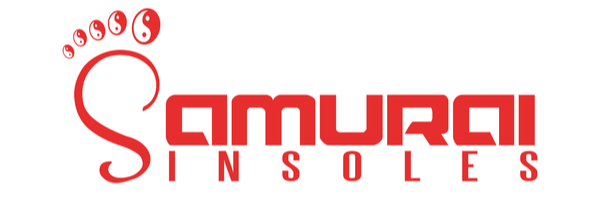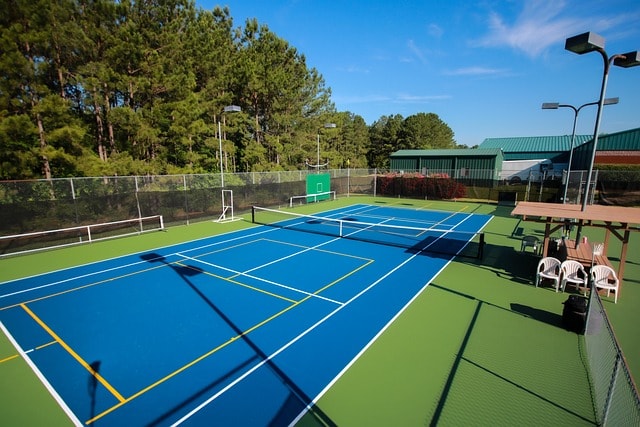You've probably heard the term "overpronation," but what does it really mean? Simply put, it's when your foot rolls too far inward as you walk or run. It’s a sneaky movement pattern that many people don't even realize they have.
But if you ignore it, this subtle foot roll can set off a chain reaction of problems. Think arch pain, shin splints, and even nagging issues in your knees, hips, and lower back.
What Is Overpronation and How Does It Affect You?
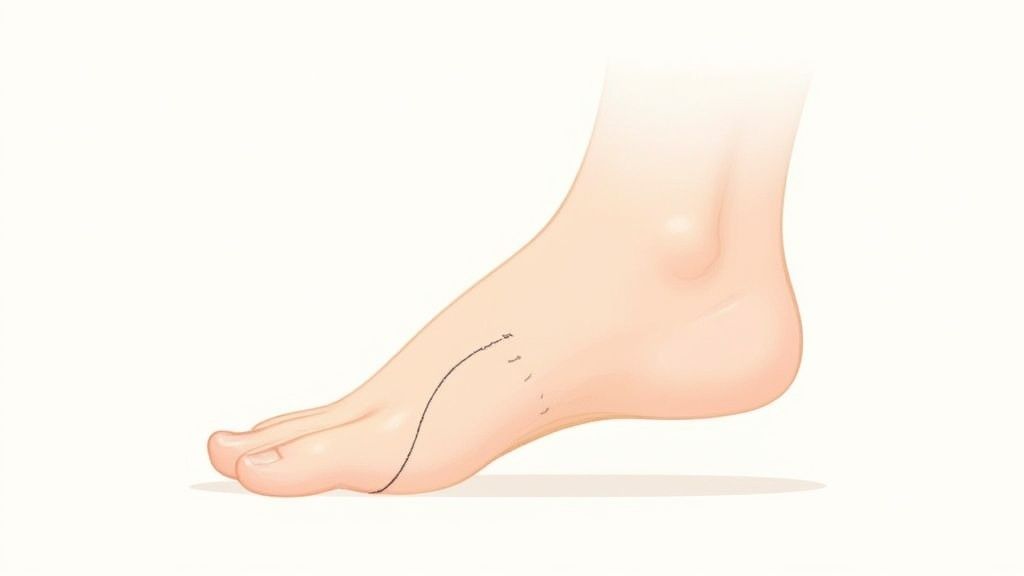
Picture your body like a tower of blocks. If the bottom block is crooked, the whole tower becomes unstable. That's a great way to think about overpronation. It isn't just a "foot problem"—it's a fundamental alignment issue that throws your entire body out of whack.
A little bit of inward roll, or pronation, is perfectly normal with every step. It’s your body’s natural shock-absorbing mechanism. The trouble starts when that roll becomes excessive, causing your arch to flatten out more than it should. That’s overpronation.
This extra motion puts a ton of stress on your feet and ankles. It’s like driving a car with misaligned tires. At first, you might not notice, but over time, the tires wear down unevenly, and the strain starts affecting the car's suspension. For your body, overpronation is often the hidden culprit behind those persistent aches and pains you can't seem to shake.
The Ripple Effect of Misaligned Feet
The trouble with overpronation is that it doesn't stay in your feet. When your ankle rolls inward, it forces your lower leg bones—the tibia and fibula—to rotate inward, too. That twist travels right up your kinetic chain, affecting your knees, hips, and even your pelvis.
This chain reaction can show up in a few common ways:
- Arch and Heel Pain: The constant pulling on the plantar fascia (the ligament running along the bottom of your foot) is a classic recipe for plantar fasciitis, which causes that sharp, stabbing pain in your heel.
- Shin Splints: When your tibia rotates, it strains the muscles along your shinbone, leading to that all-too-familiar ache we call shin splints.
- Knee Pain: A misaligned ankle puts funky pressure on the inside of your knee, which can contribute to things like runner's knee or just general achiness.
- Hip and Back Issues: With an unstable foundation, your pelvis can tilt out of alignment. To compensate, your hip and lower back muscles have to work overtime, often leading to strain and pain.
The big takeaway here is that your recurring knee or hip pain might not have anything to do with your knee or hip. The real source could be the way your feet hit the ground thousands of times a day. Fixing overpronation is about rebuilding your body's foundation.
Who Is Most at Risk?
Anyone can overpronate, but some people are more susceptible than others. For many, it's just the way they're built. Having naturally low arches or flat feet is a huge factor, as the ligaments in the foot may not be tight enough to properly support the arch.
Other things can play a role, too. For instance, pregnancy can cause ligaments to loosen throughout the body, making arches more likely to collapse. Runners who put in a lot of miles are also at high risk because the repetitive impact amplifies any small biomechanical flaw.
And, of course, your shoes matter. Wearing flimsy footwear with zero arch support can take a minor tendency to overpronate and turn it into a chronic, painful problem. Pinpointing these causes is the first real step toward finding relief.
How To Spot The Signs Of Overpronation Yourself
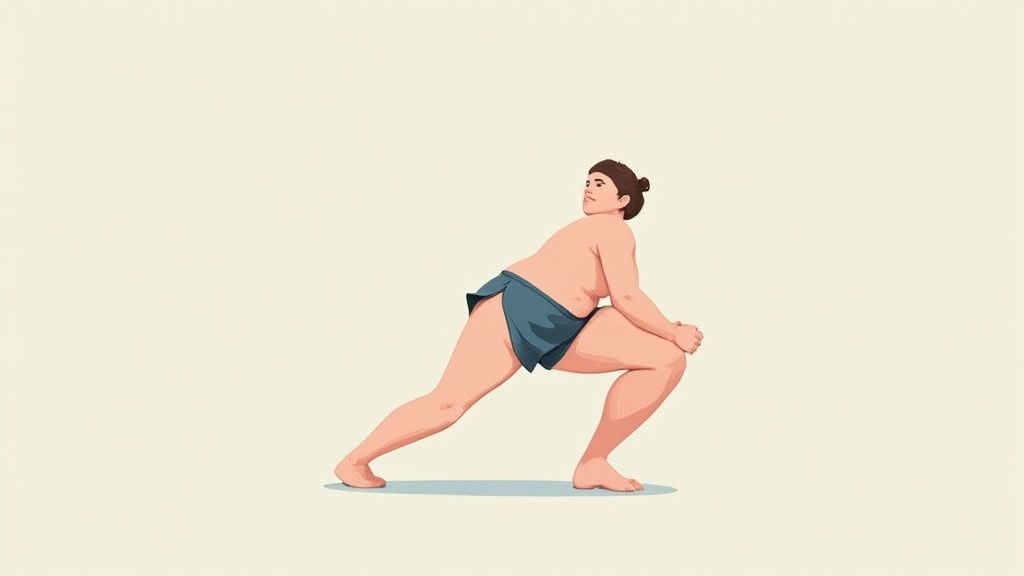
You don't need a fancy gait analysis lab to figure out if your feet are rolling inward too much. Some of the most revealing clues are right there in your own home, if you know where to look. With a few simple at-home checks, you can get a surprisingly accurate picture of your foot mechanics.
Think of it as playing detective with your own body. Your old shoes, your footprints after a shower, and even a quick glance in the mirror can offer some major "aha!" moments. These DIY assessments are a fantastic starting point for anyone wondering if overpronation is the culprit behind their aches and pains.
Check Your Shoe Wear Patterns
Your shoes tell a story. Go grab a pair of well-worn sneakers or flats—the ones you’ve really put the miles on—and set them on a table to inspect the soles.
What are you looking for? Excessive wear on the inside edge of the sole, particularly around the heel and under the ball of the foot. If the inner part of your shoe is worn down way more than the outer part, that's a classic sign your foot is collapsing inward with every step.
A person with a neutral gait will show wear that's fairly centered, maybe starting slightly on the outside of the heel and moving toward the middle. An overpronator's wear pattern, on the other hand, is unmistakably biased toward the inside.
Have you ever noticed your shoes tilting inward when you place them on a flat surface? That’s a huge visual cue. The shoe's inner wall is literally breaking down from the constant inward pressure caused by overpronation.
Perform The Wet Test
This is a time-tested method for checking out your arch height, which is a key factor in overpronation. It’s incredibly simple and gives you a clear visual of how your foot makes contact with the ground.
Here’s how you do it:
- Get prepped. Fill a shallow pan with a bit of water and place a piece of heavy paper or a flattened cardboard box next to it.
- Make your mark. Wet the bottom of one foot, making sure the entire sole is covered.
- Step and see. Carefully step onto the cardboard, putting your normal weight on your foot for a second, then step off.
Now, take a look at the footprint you left behind. A person with a healthy, normal arch will see an imprint of their heel, the ball of their foot, and a noticeable curve along the outside.
If you see an imprint of almost your entire foot, with very little or no curve on the inside, you likely have low arches or flat feet—a major contributor to overpronation. This test gives you a great snapshot of your foot's structural support system (or lack thereof).
Do A Mirror and Video Check
Sometimes, you just have to see it for yourself. Stand barefoot in front of a full-length mirror with your feet about hip-width apart, pointing straight ahead. Now, look down at your ankles.
Do you see the inner ankle bone bulging inward? Or does your Achilles tendon seem to curve inward as it runs down to your heel? These are dead giveaways that your ankle joint is collapsing inward.
For an even clearer view, ask a friend to take a short video of you walking away from them. When you play it back, especially in slow motion, you can often see that excessive inward roll of the ankle right after your heel hits the ground. It's a real eye-opener.
To make things easier, here's a quick checklist to guide you through these at-home assessments.
Overpronation Self-Assessment Checklist
This quick reference guide can help you identify the common signs of overpronation using the simple checks we've just covered.
| Symptom or Test | What to Look For (Indication of Overpronation) |
|---|---|
| Shoe Wear Pattern | Excessive wear on the inside edge of the sole, especially at the heel & ball. |
| Shoes on a Flat Surface | Shoes tilt inward when viewed from behind. |
| The Wet Test | A full footprint with little to no visible arch on the inside edge. |
| Mirror Check (Standing) | Inner ankle bones appear to bulge inward. |
| Video Check (Walking) | Ankle visibly rolls inward just after the heel strikes the ground. |
Looking for these signs can give you the confidence to take the next step, whether that's trying targeted exercises or finding the right supportive footwear.
Finding Shoes and Insoles That Actually Work
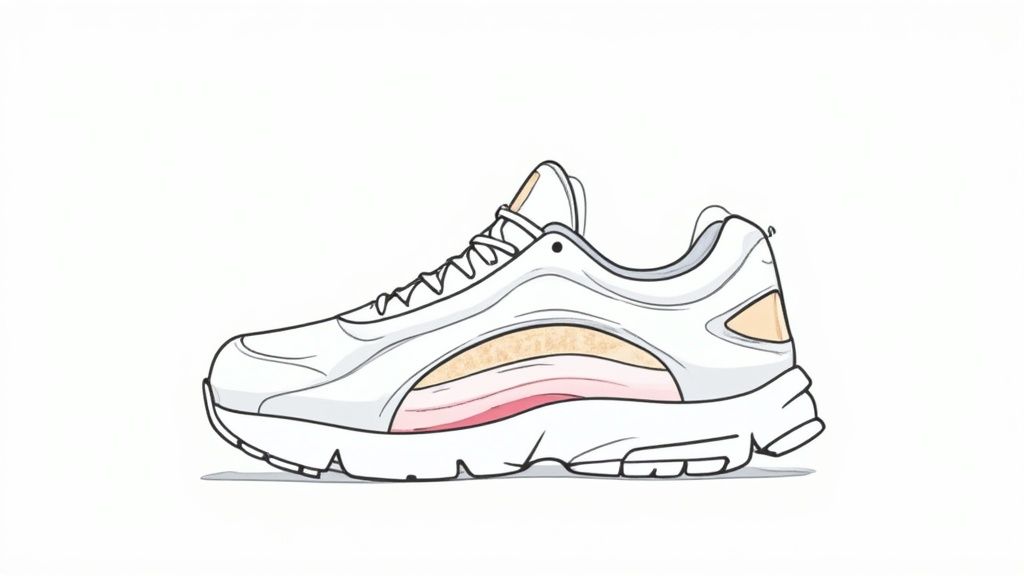
Walking into a shoe store can feel overwhelming, especially when you're bombarded with marketing buzzwords like "maximum cushion" and "ultimate support." When you're dealing with overpronation, you need to cut through that noise. The right shoe isn't just a soft pillow for your foot; it's a stable platform that helps guide your gait back to where it should be.
The trick is to look past the flashy colors and focus on the shoe's actual construction. Many modern running and walking shoes are built with stability in mind, but you have to know what you're looking for.
What to Look for in a Supportive Shoe
Next time you’re shoe shopping, don't just try them on. Give them a quick physical exam. A truly supportive shoe for overpronation should have a strong, sturdy structure in a few key places.
- Firm Heel Counter: Grab the back of the shoe where your heel sits and give it a good squeeze. It shouldn’t collapse. A firm heel counter is your first line of defense against your heel rolling inward.
- Minimal Midfoot Twist: Hold the shoe by the heel and toe and try to wring it out like a dishcloth. A flimsy shoe that twists easily in the middle isn't going to give your arch any real support. You want resistance.
- Correct Flex Point: Bend the shoe. It should bend where the ball of your foot is, not in the middle of the arch. A shoe that folds in half lacks the structural integrity you need.
Finding a shoe with these features is a huge step. And if you're dealing with related pain, you can get even more specific. For example, since overpronation can often lead to Achilles issues, looking into running shoes designed to address Achilles tendonitis can provide targeted relief.
The Real Game-Changer: Orthotic Insoles
A great shoe sets the stage, but a quality orthotic insole is what truly delivers targeted overpronation correction. Think of these inserts as a tool engineered to support your arch from below, preventing it from collapsing with every step and gently guiding your foot into a more neutral position.
An over-the-counter insole isn't just a slab of foam; it’s a biomechanical device. A well-designed option like Samurai Insoles is specifically crafted to control that excessive motion without feeling like you have a rock in your shoe, making it a powerful and accessible first step.
The need for these solutions is massive. The global market for foot orthotic insoles, which includes products for overpronation, was valued at USD 3.17 billion in 2022 and is only expected to grow.
Choosing the Right Insole for You
So, what kind of insole do you need? You really have two options: expensive, custom-molded orthotics from a podiatrist or a well-made, over-the-counter insole.
While custom orthotics are tailored perfectly to your foot, they come with a hefty price tag and are often more than what most people need. For many, a high-quality, pre-made insole hits the sweet spot of support, comfort, and value. They are designed using data from thousands of feet to address the common biomechanical patterns of overpronation. If you want to dive deeper, our guide on orthotic insoles for overpronation explains how they work in more detail.
When you're picking an insole, find one that provides firm yet flexible support. The goal is to gently cradle the arch, not force it into an uncomfortable, rigid position. By pairing a stable shoe with a quality insole, you create a powerful one-two punch for managing overpronation and finally finding some lasting relief.
Exercises That Build a Stronger Foundation
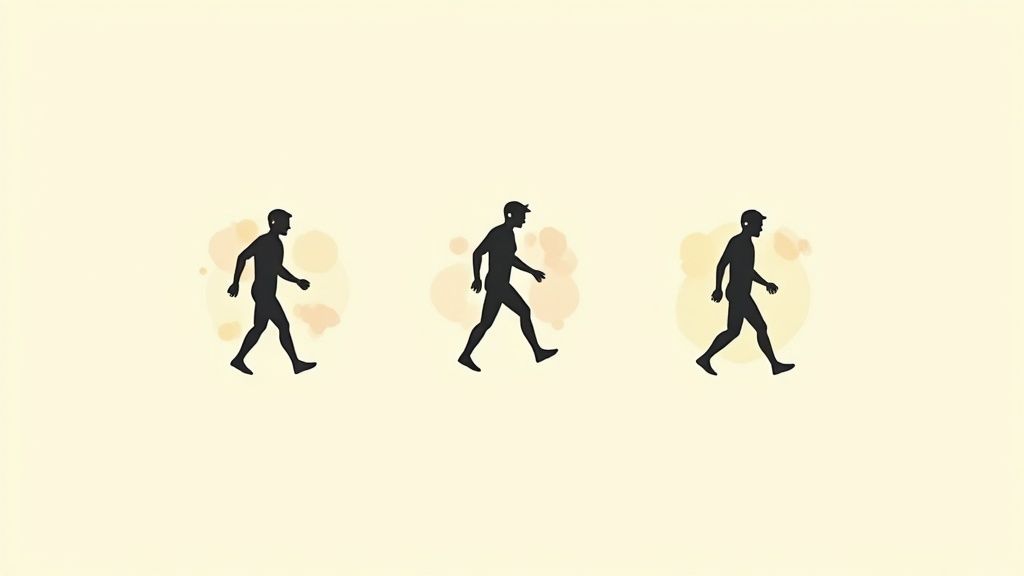
While the right shoes and insoles are fantastic tools for managing overpronation symptoms, they're only part of the solution. For genuine, lasting overpronation correction, we have to build strength from the ground up.
Think of it like this: insoles provide external support, like a temporary brace. But targeted exercises work to rebuild the very muscles that should have been providing that support in the first place. By strengthening the small muscles in your feet and the larger ones up through your legs and hips, you create a far more stable foundation. This is how you truly fix the muscular imbalances that let your arches collapse and ankles roll in.
Strengthening Your Feet and Arches
The muscles inside your feet play a massive part in holding up your arch. When they’re weak, your arch just can't handle the pressure of your body weight. The good news is that a few simple exercises can wake them up and build them back.
One of my go-to recommendations is the towel curl. Just sit in a chair, place a small towel on the floor, and use only your toes to bunch it up and pull it toward you. You'll feel it working the muscles under your foot almost immediately. Another great one is to simply try lifting your arch while keeping your heel and toes flat on the floor—hold that little squeeze for a few seconds.
Here's a pro tip: Consistency beats intensity every time. Doing these simple movements for just a few minutes daily is way more effective than one long, grueling session a week. You're training those muscles to support you automatically.
Improving Ankle and Leg Stability
Overpronation is never just a "foot problem." It's a chain reaction that involves your entire lower leg. Having flexible calves and strong stabilizing muscles is absolutely critical for controlling how your foot lands and rolls.
Here are a few key exercises that target these surrounding structures:
- Calf Stretches: Tight calves can really mess with your ankle's range of motion and actually encourage pronation. Face a wall, step one foot back, and keep that back leg straight with the heel down. Lean in until you feel a good stretch and hold for 30 seconds.
- Calf Raises: This is a classic for a reason. Stand with your feet flat, then slowly lift your heels as high as you can. Pause at the top to really engage the muscles. This directly strengthens the calves that help control your ankle.
- Clamshells: This one targets your hips, but it's crucial for your feet. Lie on your side with your knees bent and feet stacked. Keeping your feet together, lift your top knee up. This strengthens a key hip muscle (the gluteus medius) that stops your knee from collapsing inward—a common downstream effect of overpronation.
If you're looking for more ideas to mix into your routine, exploring different foot stretches for flat feet can give you a well-rounded plan.
A Holistic Approach to Strength
Strengthening these specific areas is a phenomenal start. But to build a truly resilient base, you have to think bigger than just your feet and ankles.
It's no surprise that the market for supportive products is growing. The global prosthetics and orthotics market, which is essential for overpronation correction, hit a value of about USD 8.79 billion in 2024 and is projected to keep climbing.
Beyond specific exercises, improving your overall fitness contributes to better movement patterns and less strain on your joints. Learning how to get stronger overall complements the targeted work you're doing. When you combine this with the right insoles, you've created a powerful strategy for real, long-term relief.
Creating Your Long-Term Management Plan
Real, lasting overpronation correction isn’t a one-and-done deal. It’s not a finish line you cross. Instead, think of it as a commitment to healthier habits for the long haul—a new way of living that puts your body's foundation first. It's all about weaving together consistent exercise, smarter footwear choices, and the dedicated use of supportive insoles until it becomes second nature.
This long-term strategy is about shifting your mindset. You're moving from just reacting to pain to proactively building and maintaining proper alignment and stability. It's about creating a solid foundation that supports not just your feet, but your entire body.
The Power of Consistency and Awareness
Your body adapts through repetition. Knocking out your strengthening exercises once a week here and there just won't cut it. But dedicating five to ten minutes a day to routines like towel curls or calf raises? That’s how you train your muscles to provide the constant, almost subconscious support you need.
The same idea applies to your shoes. When you consistently choose footwear with a firm heel and solid structure, and you pair them with your orthotic insoles, you reinforce proper alignment with every single step. This constant, gentle guidance helps retrain your gait over time.
A huge piece of the puzzle is simply developing mindfulness about how you stand and walk. When you're waiting in line at the grocery store, are you letting your weight fall to the inside of your feet? Do you feel your arches start to sag when you get tired? Just noticing these tendencies is the first real step toward correcting them.
This awareness isn't just about your feet. It's about understanding how your foot mechanics send ripples up through your entire body. Fixing overpronation can do wonders for your overall biomechanics and posture. It's no surprise that the global posture correction market, valued at USD 1,017.6 million in 2021, is expected to nearly double by 2030. People are finally recognizing the connection. You can explore more about how the global posture correction market is growing and its crucial link to musculoskeletal health.
Knowing When to Refresh Your Gear
Even the best equipment has a lifespan. A critical part of any good management plan is knowing when it's time to replace your shoes and insoles—before they lose their supportive mojo and stop helping your overpronation.
- Running Shoes: A good rule of thumb is to swap them out every 300-500 miles. The cushioning foam in the midsole breaks down long before the treads on the bottom look worn out.
- Everyday Shoes: For the shoes you live in, give them a good look-over every 6-12 months. Check for uneven wear on the sole, especially on the inside edge, and see if the heel counter feels mushy or collapses easily when you squeeze it.
- Insoles: High-quality options like Samurai Insoles are built to last, but they aren't invincible. Depending on how active you are, plan on replacing them every 6-12 months to make sure you’re always getting the best possible support.
By making these simple checks a routine, you ensure your foundation stays solid. It's also incredibly helpful to know the difference between various types of foot roll. For a deeper dive, check out our guide on overpronation vs. supination solutions. Building these small habits is what truly transforms temporary relief into a sustainable, active, and pain-free life.
Got Questions About Overpronation? We've Got Answers.
As you start tackling overpronation, it's totally normal to have a few questions pop up. Getting clear on the details can make a huge difference in how well you manage it. Let’s walk through some of the most common ones I hear from people just like you.
Lots of folks ask if overpronation and flat feet are the same. It's a great question because they're definitely related, but they aren't identical. Think of it like this: having flat feet is a structural thing—your arches are naturally low. This makes you much more likely to overpronate.
But you can also have a decent arch and still overpronate if your foot muscles are weak or your ligaments are a bit loose. So, flat feet is a type of foot, while overpronation is a pattern of movement.
Can I Get Rid of Overpronation for Good?
This is the big one, isn't it? Can you actually "cure" overpronation forever?
The honest truth is that it's more about smart, long-term management than a one-and-done fix. For most people, overpronation is tied to the way their feet are built. You can't change your bone structure, but you can absolutely change how your feet function day-to-day.
By consistently doing the right exercises, wearing proper shoes, and using supportive insoles, you can strengthen the muscles holding up your arch and retrain how you walk. This approach corrects the effects of overpronation, which is what actually leads to a pain-free life. It's not about getting a new pair of feet, but teaching the ones you have to work a whole lot better.
How Long Does It Take to Feel Better?
I know you want relief now, and the good news is you won't have to wait forever. How quickly you feel a difference really comes down to what you're doing and how consistent you are.
-
With Supportive Insoles: This is where you get the quickest win. Many people feel a sense of immediate comfort and better alignment the first time they slip them in. You'll likely notice real pain reduction and biomechanical improvements within one to two weeks of wearing them regularly.
-
With Strengthening Exercises: Building real, functional strength takes a bit more patience. While you might feel the muscles working from day one, it typically takes about four to six weeks of consistent effort to notice a real improvement in stability and less foot fatigue.
The secret sauce? Doing both at the same time. Insoles give you immediate support and take the strain off, which creates a pain-free opportunity to do the exercises that build lasting strength.
Do I Have to Wear Supportive Shoes All the Time?
This is a very practical concern. Are you doomed to wear chunky orthotic shoes 24/7? Not at all, but consistency is definitely your friend, especially when you're first starting out. When you’re actively trying to fix your gait and get out of pain, giving your feet consistent support is the main goal.
Here's how I think about it: for the times you're on your feet the most—at work, out for a long walk, or exercising—supportive shoes with a quality insole are non-negotiable. But if you're just kicking back at home, being barefoot for a little while can actually help strengthen your feet.
The key is to avoid spending hours in shoes that do nothing for you, like flimsy flip-flops or those old, worn-out sneakers you love. That'll just undermine all your hard work.
Ready to give your feet the foundation they need to finally beat overpronation? The right insoles can be a total game-changer. See for yourself how Samurai Insoles deliver the targeted arch support and stability you need to walk with comfort and confidence.
Check out our collection today at https://samuraiinsoles.com.
